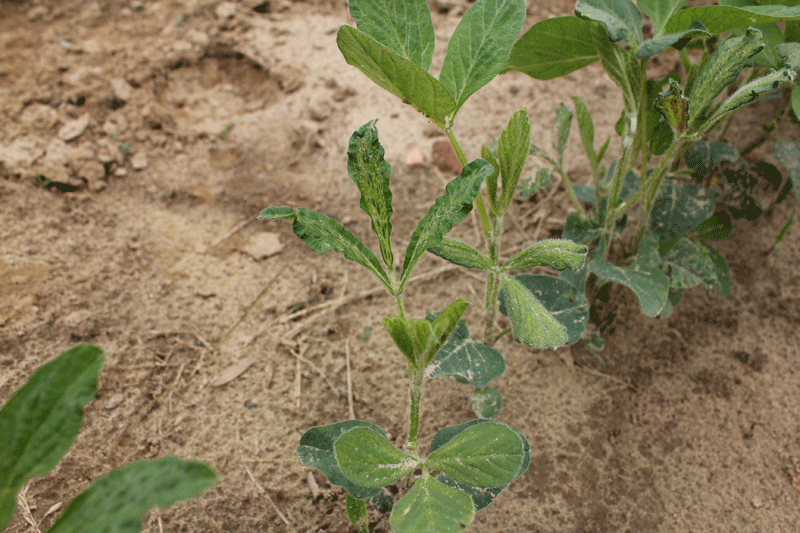Preventing herbicide injury
FIVE MISTAKES TO AVOID WITH SOYBEANS
HERBICIDES ARE GREAT tools for growers, but when used incorrectly there is always the risk that they will not work at all — or worse, that they will injure the crop in question. Mike Cowbrough, weed specialist with the Ontario Ministry of Agriculture, Food and Rural Affairs, has tracked common mistakes growers make that cause injury to their soybean crops. In some cases, the injury was caused by mistakes that were in direct violation of the herbicide label.
PHOTO: 2,4-D ESTER INJURY TO SOYBEAN.

It is extremely important to carefully read the directions on the label before applying any herbicide — particularly ones designed to work within a specific plant system. Common mistakes include applying herbicides when target weeds are too large, using an application rate that is too high (or too low), not being cognizant of herbicide carryover, and improper cleaning of sprayer tanks and lines.
WRONG RATE
With some herbicides, when a higher than labeled rate is used, injury can occur. With 2,4-D, for instance, which is registered for control of glyphosate-resistant Giant ragweed in soybean, there are special circumstances that increase the risk of crop injury. In general, says Cowbrough, the risk of injury increases in pre-plant applications when a higher than labeled rate is used, when applied later than seven days prior to planting, and under certain environmental conditions (2,4-D should not be applied when conditions are cool or wet).
WRONG TIMING
Labels clearly outline the best timing for applications. Incorrect timing could lead to severe crop injury. For example, Fierce, a new broad-spectrum herbicide that uses flumioxazin (group 14: Valtera) and pyroxalsulfone (group 15), must be applied prior to crop emergence, either prior to or shortly after planting. When applied at the wrong time, injury can occur.
“The flumioxazin portion of this herbicide will severely ‘burn’ any green leaf tissue,” Cowbrough explains. “And in one case I’ve seen, the burning was so severe that the growing point was killed in half the plants, while the surviving plants branched off new stems at the nodes above the cotyledons.”
Another broad-spectrum herbicide, Optill, which uses imazethapyr (group 2: Pursuit) and saflufenacil (group 14: Eragon), should also be applied pre-plant. “Since imazethapyr can be applied both pre- and post-emergence to soybean, a couple of growers unfortunately found out the hard way that the saflufenacil portion of this herbicide will burn off any leaf tissue when applied to emerged soybeans,” says Cowbrough.
HERBICIDE CARRYOVER
Many herbicides are broken down by microbial action. Under some situations, however, the process can be slowed by environmental factors, including drought and low soil pH. Herbicide carryover can lead to crop injury.
In 2013, Cowbrough received two calls from growers who had recently rented new land, which they planted into winter wheat. In both cases, the land was much smaller than the growers had initially thought. After spraying their fields for weeds — using, in this case, Infinity (pyrosulfotole/bromoxynil) and Refine SG (tribenuron/thifensulfuron) — there was spray solution left over.
“Normally, one would dilute the solution and apply over the same field,” says Cowbrough. “However, in both instances they applied the wheat herbicide over ground intended for soybeans.”
The growers were lucky, he says — because 2013 was a wet year, the products broke down fairly quickly. “In a drier than normal year, the potential for injury would have been greater,” he explains.
TANK CONTAMINATION
Improper cleaning of tanks and lines can also lead to crop injury, as it did in the following cases. In one instance, tank contamination by a very low rate of a post-emergent corn herbicide, VIOS G3 (tembotrione/ thiencarbazone-methyl) led to bleaching, stunting, and leaf distortion. In this case, the bleaching was caused by tembotrione, and the stunting and leaf distortion were caused by thiencarbazone-methyl.
In another case, tank contamination from dicamba on soybeans due to improper sprayer cleanout led to stunting, leaf cupping, and darkening of leaf tissue. “The impact on yield will depend on the level of stunting,” says Cowbrough. “If injury is simply leaf distortion with no internode stunting, field experience has shown the impact to be small.”
NOT TESTING LOCAL CONDITIONS
Sometimes growers come across scientific articles that motivate them to try combinations of herbicides in an attempt to control weeds beyond their optimum stage of growth. As one grower learned the hard way, this does not always lead to the best results.
After reading an article outlining experiments that were conducted at 12 locations in North Carolina and Virginia to determine soybean response to post-emergence herbicide mixtures containing 2,4-DB, he decided to test out one of the combinations at home. While in some cases, research has shown that combinations of post-emergence herbicides with 2,4-DB can increase weed control when weeds are beyond the optimum size for control with acifluorfen or bentazon, for example; or in situations where conditions are less than optimum for control — but sometimes these combinations lead to yield loss and crop injury. As the grower found out, experiments like this should always be field-tested to local conditions, says Cowbrough.
For best results, always read herbicide labels carefully and thoroughly. Be sure to apply herbicides at the right time and at the correct rate. Thoroughly clean sprayer equipment — tanks and lines — to avoid contamination, be aware of and avoid situations that could lead to injury due to carryover, and always field test before trying something new. •

















